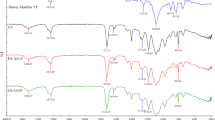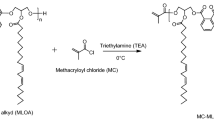Abstract
In this research, high-performance epoxy acrylate (EA) coating formulations that contain various acrylate-modified diepoxy siloxane (DESA) intermediates were synthesized and characterized. Firstly, diepoxy siloxane (DES) intermediates, which have varying chain lengths (Mw = 370–3300 Da), were modified by acrylic acid via the ring-opening reaction oxirane group. DESA intermediates were then used in the preparation of ultraviolet (UV)-curable EA formulations. EA was also synthesized via acrylic acid modification of a commercial bisphenol-A-based epoxy resin, used as the standard formulation. EA-based UV-curable formulas were applied on substrates and then cured by UV irradiation for investigating the coating performances. Subsequently, performances of the UV-cured coatings were evaluated by the various test techniques, such as hardness, gloss, cross-cut adhesion force scratch resistance, contact angle, yellowing resistance, abrasion resistance, chemical resistance, and color measurement. The effect of DESA variety on the formations was examined compared to both themselves and the standard formulation. The results showed that the varying amounts and chain lengths of DESA influenced UV-curable coatings’ properties; particularly, the scratch resistance, contact angle, and yellowing resistance significantly enhanced with the increasing chain length of DESA. High-performance UV-curable EA formulations could be produced with the scratch resistance of 4 N, the contact angle of 95°, and high yellowing resistance (ΔE = 0.35).








Similar content being viewed by others
References
Saman, NM, Ang, DTC, Shahabudin, N, et al. “UV-Curable Alkyd Coating with Self-healing Ability.” J. Coat. Technol. Res., 16 465–476 (2019)
Wang, Y, Liu, F, Xue, X, “Morphology and Properties of UV-Curing Epoxy Acrylate Coatings Modified with Methacryl-POSS.” Prog. Org. Coat., 78 404–410 (2015)
Ding, J, Liang, H, Shi, W, et al. “Photopolymerization and Properties of UV-Curable Flame-Retardant Resins with Hexaacrylated Cyclophosphazene Compared with Its Cured Powder.” J. Appl. Polym. Sci., 97 1776–1782 (2005)
Karataş, S, Hoşgör, Z, Kayaman-Apohan, N, et al. “Preparation and Characterization of Phosphine Oxide Containing Organosilica Hybrid Coatings by Photopolymerization and Sol-Gel Process.” Prog. Org. Coat., 65 49–55 (2009)
Kardar, P, Ebrahimi, M, Bastani, S, et al. “Using Mixture Experimental Design to Study the Effect of Multifunctional Acrylate Monomers on UV Cured Epoxy Acrylate Resins.” Prog. Org. Coat., 64 74–80 (2009)
Mohtadizadeh, F, Zohuriaan-Mehr, MJ, ShirkavandHadavand, B, et al. “Tetra-Functional Epoxy-Acrylate as Crosslinker for UV Curable Resins: Synthesis, Spectral, and Thermo-Mechanical Studies.” Prog. Org. Coat., 89 231–239 (2015)
Ahmad, S, Ashraf, SM, Sharmin, E, et al. “Synthesis, Formulation, and Characterization of Siloxane-Modified Epoxy-Based Anticorrosive Paints.” J. Appl. Polym. Sci., 100 4981–4991 (2006)
Boumaza, M, Khan, R, Zahrani, S, “An Experimental Investigation of the Effects of Nanoparticles on the Mechanical Properties of Epoxy Coating.” Thin Solid Films, 620 160–164 (2016)
Mousaa, IM, Ibrahim, SM, Radi, H, “Coating Characteristics of UV Curable Epoxy Acrylate Oligomer Modified with Acrylated Sunflower Oil.” Arab. J. Nucl. Sci. Appl., 47 1–13 (2014)
Liu, P, Gu, A, Liang, G, et al. “Preparation and Properties of Novel High Performance UV-Curable Epoxy Acrylate/Hyperbranched Polysiloxane Coatings.” Prog. Org. Coat., 74 142–150 (2012)
Işin, D, Kayaman-Apohan, N, Güngör, A, “Preparation and Characterization of UV-Curable Epoxy/Silica Nanocomposite Coatings.” Prog. Org. Coat., 65 477–483 (2009)
dos Santos, MN, Opelt, CV, Lafratta, FH, et al. “Thermal and Mechanical Properties of a Nanocomposite of a Photocurable Epoxy-Acrylate Resin and Multiwalled Carbon Nanotubes.” Mater. Sci. Eng. A, 528 4318–4324 (2011)
Lin, HM, Wu, SY, Chang, FC, et al. “Photo-Polymerization of Photocurable Resins Containing Polyhedral Oligomeric Silsesquioxane Methacrylate.” Mater. Chem. Phys., 131 393–399 (2011)
Xiao, X, Hao, C, “Preparation of Waterborne Epoxy Acrylate/Silica Sol Hybrid Materials and Study of Their UV Curing Behavior.” Colloids Surfaces A: Physicochem. Eng. Asp., 359 82–87 (2010)
Xing, W, Song, L, Wang, X, et al. “Preparation, Combustion, and Thermal Behavior of UV-Cured Epoxy-Based Coatings Containing Layered Double Hydroxide.” Polym. Adv. Technol., 22 1859–1864 (2011)
Riaz, S, Park, SJ, “A Comparative Study on Nanoinclusion Effect of MoS2 Nanosheets and MoS2 Quantum Dots on Fracture Toughness and Interfacial Properties of Epoxy Composites.” Compos. Part A: Appl. Sci. Manuf., 146 106419 (2021)
PirhadyTavandashti, N, Molana Almas, S, Esmaeilzadeh, E, “Corrosion Protection Performance of Epoxy Coating Containing Alumina/PANI Nanoparticles Doped with Cerium Nitrate Inhibitor on Al-2024 Substrates.” Prog. Org. Coat., 152 106133 (2021)
Riaz, S, Park, SJ, “Effective Reinforcement of Melamine-functionalized WS2 Nanosheets in Epoxy Nanocomposites at Low Loading via Enhanced Interfacial Interaction.” Macromol. Res., 28 1116–1126 (2020)
Liu, F, Liu, A, Tao, W, et al. “Preparation of UV Curable Organic/Inorganic Hybrid Coatings-A Review.” Prog. Org. Coat., 145 105685 (2020)
Mohseni, M, Bastani, S, Jannesari, A, “Influence of Silane Structure on Curing Behavior and Surface Properties of Sol-Gel Based UV-Curable Organic-Inorganic Hybrid Coatings.” Prog. Org. Coat., 77 1191–1199 (2014)
Zamanian, M, Mortezaei, M, Salehnia, B, et al. “Fracture Toughness of Epoxy Polymer Modified with Nanosilica Particles: Particle Size Effect.” Eng. Fract. Mech., 97 193–206 (2013)
Shen, L, Li, Y, Zheng, J, et al. “Modified Epoxy Acrylate Resin for Photocurable Temporary Protective Coatings.” Prog. Org. Coat., 89 17–25 (2015)
Zhu, Q, Liang, L, Du, X, et al. “Fabrication of High-Performance Cationic UV Curable Cycloaliphatic Epoxy/Silicone Hybrid Coatings.” Macromol. Mater. Eng., 303 1–9 (2018)
Wang, H, Liu, W, Yan, Z, et al. “Synthesis and Characterization of UV-Curable Acrylate Films Modified by Functional Methacrylate Terminated Polysiloxane Hybrid Oligomers.” RSC Adv., 5 81838–81846 (2015)
Wang, W, “Synthesis and Characterization of UV-Curable Polydimethylsiloxane Epoxy Acrylate.” Eur. Polym. J., 39 1117–1123 (2003)
Croutxé-Barghorn, C, De Brito, M, Allonas, X, et al. “Organic and Hybrid Interpenetrated Polymer Networks for Advanced Materials.” J. Photopolym. Sci. Technol., 25 131–135 (2012)
Maciejewski H, Dabek I, Fiedorow R, et al. "Thermal Stability of Hybrid Materials Based on Epoxy Functional (Poly)siloxanes." J. Therm. Anal. Calorim., 110(3) 1415–1424 (2012)
Acosta Ortiz, R, Sangermano, M, Bongiovanni, R, et al. “Synthesis of Hybrid Methacrylate-Silicone-Cyclohexanepoxide Monomers and the Study of Their UV Induced Polymerization.” Prog. Org. Coat., 57 159–164 (2006)
Jung, K, Bae, JY, Park, SJ, et al. “High Performance Organic-Inorganic Hybrid Barrier Coating for Encapsulation of OLEDs.” J. Mater. Chem., 21 1977–1983 (2011)
Yang, Z, Peng, H, Wang, W, et al. “Crystallization Behavior of Poly(ε-caprolactone)/Layered Double Hydroxide Nanocomposites.” J. Appl. Polym. Sci., 116 2658–2667 (2010)
Bajpai, M, Shukla, V, Kumar, A, “Film Performance and UV Curing of Epoxy Acrylate Resins.” Prog. Org. Coat., 44 271–278 (2002)
Liu, J, Jiao, X, Cheng, F, et al. “Fabrication and Performance of UV Cured Transparent Silicone Modified Polyurethane–Acrylate Coatings with High Hardness, Good Thermal Stability and Adhesion.” Prog. Org. Coat., 144 105673 (2020)
Kim, HK, Ju, HT, Hong, JW, “Characterization of UV-Cured Polyester Acrylate Films Containing Acrylate Functional Polydimethylsiloxane.” Eur. Polym. J., 39 2235–2241 (2003)
Prabu, AA, Alagar, M, “Mechanical and Electrical Studies of Silicone Modified Polyurethane-Epoxy Intercrosslinked Networks.” Polym. J., 36 848–855 (2004)
Lee, S, Gavande, V, Chun, JH, et al. “Synthesis and Properties of UV-Curable Polyurethane Acrylates with Reactive Silicones.” Mol. Cryst. Liq. Cryst., 706 86–93 (2020)
Qi, Y, Li, L, Fang, Z, et al. “Effects of Small Molecular Weight Silicon-Containing Acrylate on Kinetics, Morphologies, and Properties of Free-Radical/Cationic Hybrid UV-Cured Coatings.” J. Appl. Polym. Sci., 131 1–10 (2014)
Socrates G. Infrared and Raman Characteristic Group Frequencies. Tables and Charts, 2001. Epub ahead of print 2001. https://doi.org/10.1002/jrs.1238.
Montané, X, Dinu, R, Mija, A, “Synthesis of Resins Using Epoxies and Humins as Building Blocks: A Mechanistic Study Based on In-Situ FT-IR and NMR Spectroscopies.” Molecules, 24 4110 (2019)
Ahmad, S, Gupta, AP, Sharmin, E, et al. “Synthesis, Characterization and Development of High Performance Siloxane-Modified Epoxy Paints.” Prog. Org. Coat., 54 248–255 (2005)
Brandolini AJ, Hills DD. NMR Spectra of Polymers and Polymer Additives. Boca Raton: CRC Press, 2000. Epub ahead of print May 2000. https://doi.org/10.1201/9781482293425.
Karlović, I, Novaković, D, Novotny, E, “The Influence of Surface Topography of UV Coated and Printed Cardboard on the Print Gloss.” J. Graph Eng. Des., 1 23–31 (2010)
Chruściel, JJ, Leśniak, E, “Modification of Epoxy Resins with Functional Silanes, Polysiloxanes, Silsesquioxanes, Silica and Silicates.” Prog. Polym. Sci., 14 67–121 (2015)
Wang, X, Chai, Y, Liu, J, “Formation of Highly Hydrophobic Wood Surfaces Using Silica Nanoparticles Modified with Long-Chain Alkylsilane.” Holzforschung, 67 667–672 (2013)
Ping, T, Zhou, Y, He, Y, et al. “Preparation and Characterization of Yellowing Resistance and Low Volume Shrinkage of Fluorinated Polysiloxane Urethane Acrylate.” Prog. Org. Coat., 97 74–81 (2016)
Acknowledgments
The authors would like to thank Kayalar Kimya’s R&D Coordinator EbruErgüven for her assistance in using laboratory facilities.
Funding
This work was supported by the Research Fund of the Istanbul University-Cerrahpasa, Grant Number 34050.
Author information
Authors and Affiliations
Contributions
YA performed the synthesis and characterization experiments and wrote the paper. All authors discussed the results and commented on the manuscript. The content is solely the responsibility of the authors and does not necessarily represent the official views of the Istanbul University-Cerrahpasa, Research Fund.
Corresponding author
Ethics declarations
Conflict of interest
The authors have no conflicts of interest to declare that are relevant to the content of this article. All authors certify that they have no affiliations with or involvement in any organization or entity with any financial interest or nonfinancial interest in the subject matter or materials discussed in this manuscript.
Additional information
Publisher's Note
Springer Nature remains neutral with regard to jurisdictional claims in published maps and institutional affiliations.
Rights and permissions
About this article
Cite this article
Atici, Y., Emik, S. & Kırbaslar, Ş.İ. Effect of siloxane chain length on thermal, mechanical, and chemical characteristics of UV (ultraviolet)-curable epoxy acrylate coatings. J Coat Technol Res 19, 439–451 (2022). https://doi.org/10.1007/s11998-021-00548-z
Received:
Revised:
Accepted:
Published:
Issue Date:
DOI: https://doi.org/10.1007/s11998-021-00548-z




